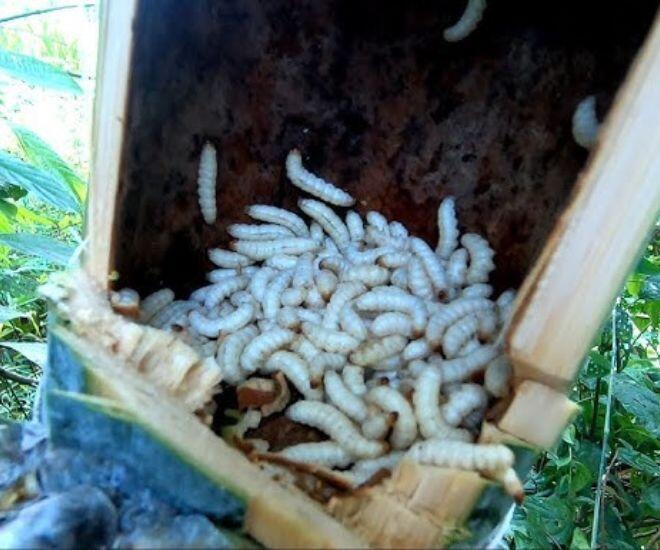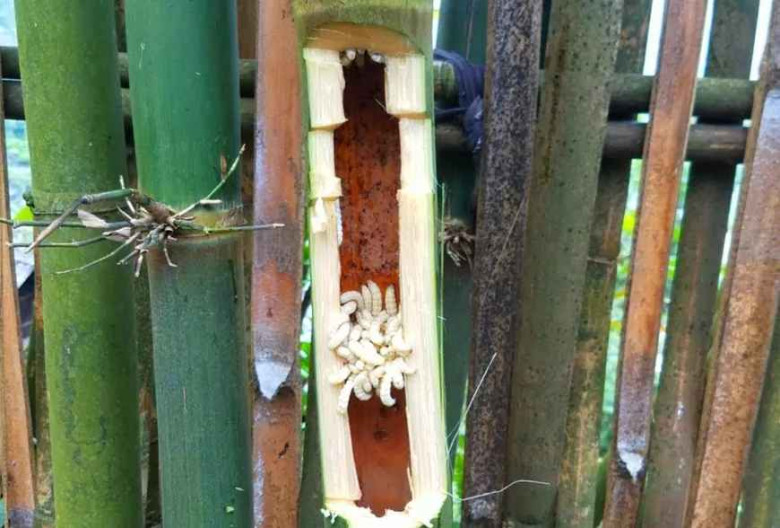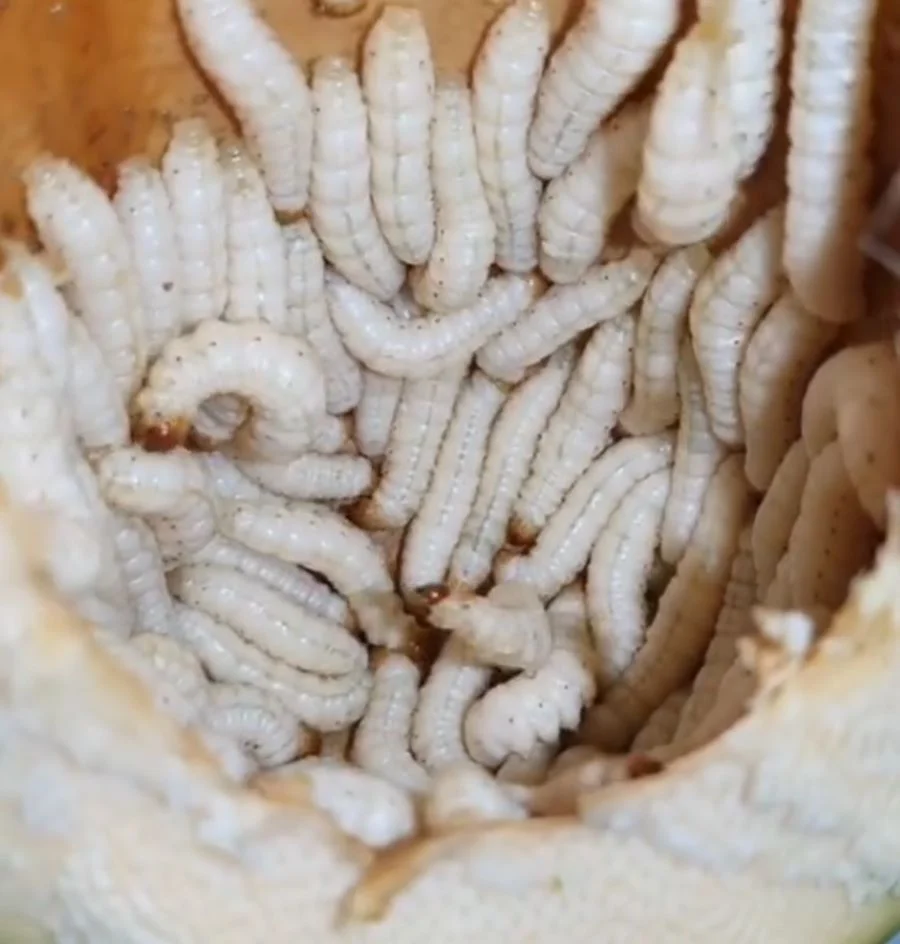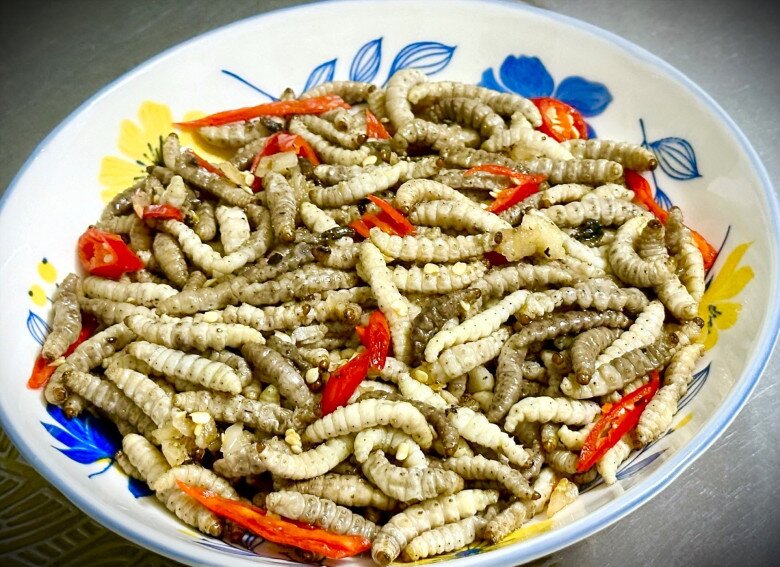
Bamboo worms, the larvae of a species of insect that dwells within bamboo stalks, are a delicacy in Vietnam’s northern mountainous regions. These creamy-white grubs, about two finger-lengths long, offer a crisp and buttery taste sensation.
As autumn arrives, especially from September to October in the lunar calendar, ethnic minorities in provinces such as Son La, Lai Chau, Cao Bang, and Bac Kan eagerly venture into the forests to harvest bamboo worms. This is the ideal time as the worms are at their most robust and flavorful, perfect for transforming into delectable dishes.

Finding bamboo worms is no easy task; it requires the keen eye and experience of seasoned forest dwellers. They don’t inhabit every bamboo tree but tend to dwell in young stalks that show signs of withering. If you spot tiny holes or abnormally contracted joints on a bamboo stalk, it’s a sure sign of worm habitation. Cutting down the stalk and splitting it open with a knife will reveal the creamy-white worms. Adult bamboo worms are small, about the size of a chopstick head, measuring around 3-4 cm in length. The bamboo worm season is fleeting, lasting just over a month, making them a rare delicacy sought after by many, often requiring advance orders or freezing for preservation.

Historically, bamboo worms were a staple in the diets of ethnic minority communities in the mountains. However, their unique flavor and high nutritional value have led to their growing popularity, especially among tourists and those from the lowlands. This increased demand has driven up prices, with fresh bamboo worms now costing between 500,000 and 700,000 VND per kilogram. They are not always readily available, even with money, unless you place an advance order with a trader. In addition to fresh or frozen bamboo worms, the market also offers crispy, packaged bamboo worm snacks, convenient for storage and transportation.

Despite their acclaimed flavor, bamboo worms, like other insects such as bee larvae or ant eggs, require careful preparation to avoid health risks. Improper handling can lead to allergies or poisoning in some individuals with specific sensitivities. To ensure safety, bamboo worms should be soaked in a diluted salt solution before cooking to eliminate any toxins and minimize the risk of poisoning.
Not only are bamboo worms a culinary delight, but they are also highly nutritious, particularly in protein content, making them a valuable addition to any diet.
Bamboo worms can be prepared in numerous mouthwatering dishes to cater to diverse palates. Among these, the two most popular and common cooking methods are stir-frying and roasting.
Bamboo Worm Stir-Fry with Lemon Leaves: This dish is simple to prepare. After cleaning and drying the bamboo worms, they are seasoned with a mixture of salt, seasoning powder, pepper, and fish sauce, marinated for about 15 minutes to absorb the flavors. Next, garlic is fried in a pan until fragrant, followed by the addition of bamboo worms, quickly stirred. Once the worms turn a light yellow color, add finely chopped lemon leaves and continue cooking for another 2-3 minutes before serving. This dish, with its vibrant yellow color and distinctive lemon leaf aroma, is perfect when served with hot rice or as a beer snack.

Bamboo Worm and Sour Bamboo Shoots Stir-Fry: This dish offers a delightful twist. Season the bamboo worms with pepper, sugar, seasoning powder, and chopped garlic and shallots. Rinse and squeeze dry the sour bamboo shoots, and finely chop the coriander leaves. Fry the garlic and shallots in a pan until fragrant, then add the bamboo worms and stir-fry until they are dry and well-seasoned. Add about three tablespoons of cooking oil and continue stirring. Toss in the sour bamboo shoots, season with fish sauce, and stir until the bamboo shoots absorb the flavors. Finally, add the coriander and chili, mixing well. This dish presents a captivating combination of colors and flavors, with the golden bamboo worms contrasting the white bamboo shoots, and the soft, buttery worms blending perfectly with the sour bamboo’s tangy taste.

In Cao Bang’s restaurants and homestays, bamboo worm dishes are a staple on the local menu and are often the most popular, quickly disappearing dishes during the season. While some tourists may initially hesitate to try this unique delicacy, most are won over by its exceptional flavor. Bamboo worms are considered a clean food source, and because they are only available seasonally, they are enthusiastically promoted by local hosts. Bamboo worms are at their best when roasted crisp with lemon leaves or wrapped in betel leaves and dipped in sour bamboo soup or pure fish sauce, offering a memorable culinary experience to anyone visiting this region.
Unveiling the Wonders of Rau Lạc Tiên: A Crunchy Northern Delicacy with Surprising Benefits
The northern region of [country/state/province] boasts not only breathtaking landscapes but also a plethora of unique specialty vegetables. Among these, the lac tien vegetable, with its distinctive tufted growth and delicious crunchy texture reminiscent of squash vines, is gaining popularity and capturing the interest of many.
The Gen Z Trendsetters: In Pursuit of the ‘Ha Giang Passport’
The Gen Z travelers are embracing a unique and exciting trend of collecting stamps as they check off famous tourist spots in Ha Giang. This innovative way of exploring the region offers a fun and memorable experience, encouraging visitors to embark on a journey of discovery and leave with a tangible keepsake of their adventures.
The Heart of Nam Dinh: Unveiling a 700-Year-Old Marketplace, Overflowing with Nostalgia and Local Pride
Stepping into this ancient market in Nam Dinh, visitors are not only immersed in the traditional architectural space with its faded tile roofs and earthen bricks but also given the chance to relive their childhood through simple rustic treats such as sweet soups, ‘banh gai’ (a type of steamed glutinous rice cake), fried dough sticks, and ‘banh dung’ (a local delicacy made from glutinous rice).
The Ultimate Guide to Grilling: Elevate Your BBQ Game with a Simple Twist
Crispy, charred edges on the pork belly, with translucent fat and a deep reddish-brown hue – this mouth-watering dish is a staple of Northern Vietnam’s summer cuisine. The aroma of fried shallots and the rich, savory flavors tantalize the taste buds. Accompanied by crab soup and fried green tomatoes, this meal is a true delight and a quintessential taste of the region’s summer fare.



































